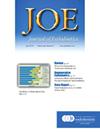探讨呋喃妥因在再生牙髓学中控制感染的潜力:体外研究。
IF 3.5
2区 医学
Q1 DENTISTRY, ORAL SURGERY & MEDICINE
引用次数: 0
摘要
本研究评估了一种含有呋喃妥因的新型抗菌糊剂配方,用于再生牙髓治疗,对抗多物种生物膜。方法:检测4组单根牙,每组11颗:阴性对照组(BHI +微生物);星野1号常规三抗生素膏体组(1:1:1比例);星野5组(5:5:5比例);实验组应用呋喃妥因、环丙沙星、甲硝唑。测定各抗菌药物的最低抑菌浓度。在根管中形成多微生物生物膜(粪肠球菌、金黄色葡萄球菌、铜绿假单胞菌、白色念珠菌),并用香菇膏插入膏体3分钟。7天后,对样品进行超声和分光光度分析。微生物测定、质膜渗透、共聚焦激光扫描显微镜(CLSM)和扫描电子显微镜(SEM)评估生物膜根除。p < 0.05为差异有统计学意义。结果:分光光度法显示实验组优于星野1组和阴性对照组(p0.05)。实验组与星野1号组和星野5号组相比,膜损伤加重。CLSM和SEM显示实验组微生物较少,无残留生物膜。结论:用呋喃妥因代替米诺环素可有效减少根管内微生物数量。本文章由计算机程序翻译,如有差异,请以英文原文为准。
Exploring the Potential of Nitrofurantoin for Infection Control in Regenerative Endodontics: In Vitro Study
Introduction
This study assessed a new antimicrobial paste formulation containing nitrofurantoin for regenerative endodontics against multispecies biofilms.
Methods
Four groups of 11 single-root teeth each were tested: Negative control group (brain-heart infusion broth + micro-organisms); Hoshino 1 conventional tri-antibiotic paste group (1:1:1 ratio); Hoshino 5 group (5:5:5 ratio); Experimental group with nitrofurantoin, ciprofloxacin, and metronidazole. Minimum inhibitory concentrations of each antimicrobial were determined. A polymicrobial biofilm (Enterococcus faecalis, Staphylococcus aureus, Pseudomonas aeruginosa, Candida albicans) was created in root canals, and pastes were inserted for 3 minutes with lentulo. After 7 days, samples were sonicated and spectrophotometrically analyzed. Microbiological assays, plasma membrane permeabilization, confocal laser scanning microscopy, and scanning electron microscopy evaluated biofilm eradication. Statistical significance was set at P < .05.
Results
Spectrophotometry indicated Experimental group outperformed Hoshino 1 group and Negative control group (P < .05), with results similar to Hoshino 5 group (P > .05). Experimental group showed increased membrane damage compared to Hoshino 1 group and Hoshino 5 group. Confocal laser scanning microscopy and scanning electron microscopy revealed fewer microorganisms and no residual biofilm in Experimental group.
Conclusions
Substituting minocycline with nitrofurantoin in the paste effectively reduced microorganism counts in root canals system.
求助全文
通过发布文献求助,成功后即可免费获取论文全文。
去求助
来源期刊

Journal of endodontics
医学-牙科与口腔外科
CiteScore
8.80
自引率
9.50%
发文量
224
审稿时长
42 days
期刊介绍:
The Journal of Endodontics, the official journal of the American Association of Endodontists, publishes scientific articles, case reports and comparison studies evaluating materials and methods of pulp conservation and endodontic treatment. Endodontists and general dentists can learn about new concepts in root canal treatment and the latest advances in techniques and instrumentation in the one journal that helps them keep pace with rapid changes in this field.
 求助内容:
求助内容: 应助结果提醒方式:
应助结果提醒方式:


